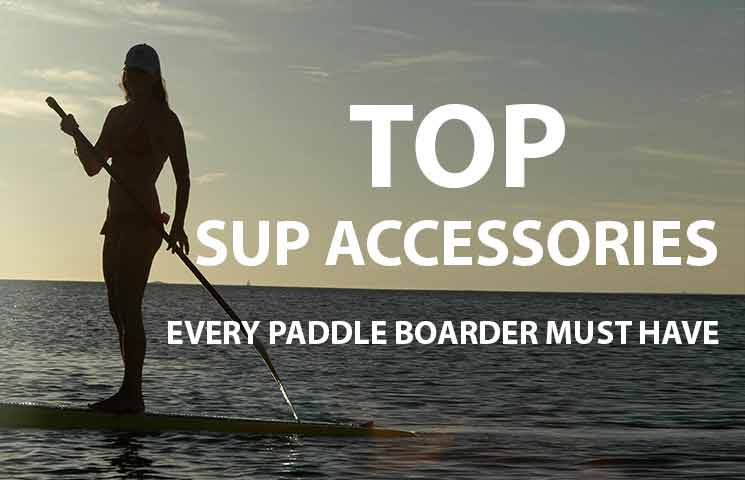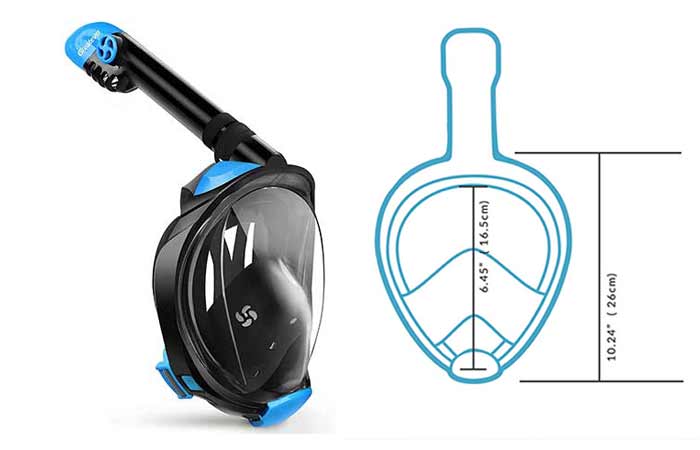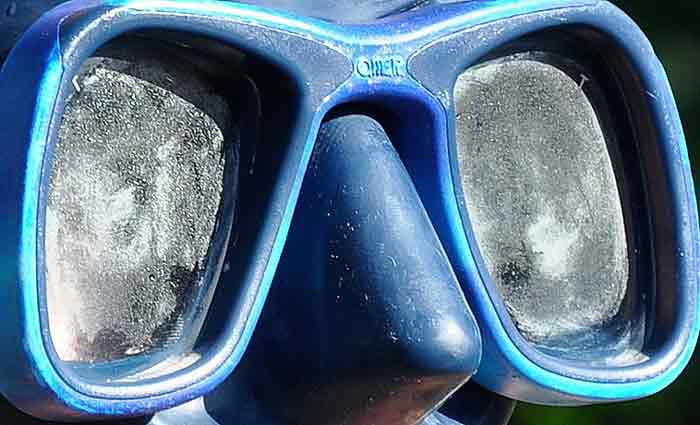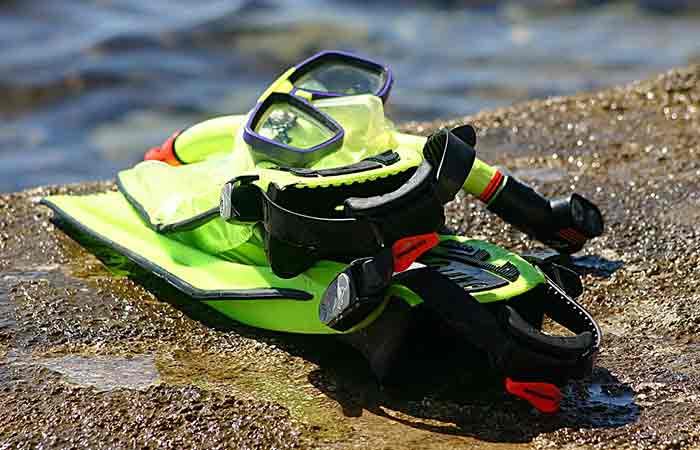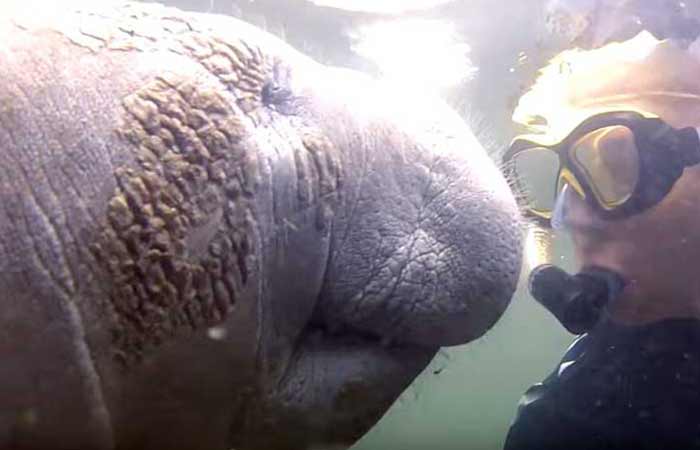Best Buoyancy Compensator Devices (BCD) for Scuba Diving & Snorkeling
Buoyancy compensators are devices that can be worn by scuba divers to make staying underwater and floating easier.
Although they keep you afloat just like life jackets, buoyancy compensators are much more sophisticated and will help divers stay at the same depth without necessarily making the needed movements. They do this by compressing air inside of a bladder placed on your back and inflating or deflating depending on what is needed.
The following is a review of the best BCDs plus a detailed guide on how to choose the right buoyancy compensator device for yourself or someone you care about. Following is a highlight of the best BCDs
| BC Device | Features | Details | Price |
|---|---|---|---|
Jacket style BCD ideal for Beginners-Weight Pockets, D-rings, 3 exhaust valves |
|||
Wrap-around jacket with weight integration, with dive computer & Regulator |
|||
Lightweight Travel-Friendly , Back Inflation BCD |
|||
Front-adjustable type with huge lift capacity, pockets, water-draining airnet backpack, D-rings & alternate Air Source |
|||
2-in-1 bag and travel BCD,30lbs lift, One size fits all, Adjustable position weight pockets |
|||
Lightweight, durable and rugged begginer/intermediate BCD jacket with removable pockets,3-exhaust valves |
|||
Minimalistic lightweight recreational BC, comfort molded backpad, pinch and pull weight pockets, comfort molded backpad New 10lb pinch and pull weight pockets, D-rings & Adjustable sternum strap |
|||
Specifically for kids, lightweight, adjustable chest strap with Velcro closure, integrated weight system, Mesh Pockets |
What is Buoyancy Compensator Device (BCD)?
A buoyancy compensator device, also called a stabilizer or buoyancy control device, is a device worn by scuba divers to control buoyancy by establishing positive buoyancy at the surface and negative buoyancy underwater.
There are many different types of BCDs, and they differ in weight capacity, comfort level, best use for diving decisions, and other aspects.
A BCD is attached to the diver’s wetsuit or dry suit with straps that go around a person’s neck and torso. The most common type of buoyancy compensator device is called a “jacket style” BCD because it wraps around the chest like a jacket and attaches at each end near the waistline on either side of the diver’s hips (front-entry models).
Another popular design has shoulder straps which attach behind the back instead of over one’s shoulders (rear entry models).
How does a BCD work?
A buoyancy compensator device works by inflating the vest and adding buoyancy to a diver. The amount of gas in the BCD can be adjusted through valves that allow air into or out of smaller balloons (known as cells) inside the device.
Inflate your BC by adjusting the two valves on your right-hand side, which control pressure inflation and exhaust respectively.
A buoyancy compensator device has the following components:
- A backplate.
- A gas overflow relief valve which releases excess air from the buoyancy compensator device whenever the diver overinflates the tank.
- A weight system to control the amount of lift in water.
- An adjustable harness, which can be used for surface support and as a leg strap while underwater. The best buoyancy compensator devices have shoulder straps that hold up to three different tanks on your back, allowing you to use more air without feeling weighted down by heavy gear all day long.
- One or more metal-D rings to attach slates and other accessories.
- Air bladder which is inflated by the diver. This inflator hose should be routed over the right shoulder so it can easily be reached during inflation
- A vent valve which is used to control the release of the gas as controlled by the diver.
The best buoyancy compensator devices will help you stay afloat in water with minimal effort required from your lungs while at the same time allowing you to control how much air is inside your BCD. You can also use a BCD as life support when ascending too quickly, making ascents easier on both your body and mind.
The buoyancy compensator device works in the following ways:
1. Getting the right fit and size
The first thing to consider is that the best buoyancy compensator devices are made in various sizes, and you need to make sure that your choice will fit properly.
The best way is to read a few reviews from others who have tried out different options if you can’t try them out yourself.
You should also think about what type of body shape or size you typically wear before purchasing one online with no additional information on sizing available. A cost-effective option for this would be to buy two or three at once so they can all be worn when diving together with friends
Some BC models come in adjustable sizes which allows them to better accommodate people of varying heights and weights. It’s best not go too big as this may cause difficulty while trying to inflate it. The best way to avoid this is by using a BCD that has adequate size increments.
A good place to start looking for different styles, colors and sizes of best buoyancy compensator devices is at your local diving store because they will usually carry the best brands in stock.
You can also do an online search or check out sites like Amazon which typically have quick turnaround time on new inventory arrivals.
2. The states of buoyancy
There are three states of buoyancy:
- Positive (buoyant) state: the diver’s weight is less than the water’s average density.
- Neutral/zero balance state: the diver’s weight and volume are equal.
- Negative (submerged) state: diver’s weight is more than the water’s average density, so they sink until air in their lungs pushes out enough water to compensate for the difference between the densities.
Buoyancy compensator devices help us stay at a certain depth or swim up towards the surface by letting our body take advantage of different states of buoyancy while we float on top.
3. Orientation in the water
A buoyancy compensator device also influences the orientation of the diver in the water.
The buoyancy compensator device decreases your natural tendency to float face down in the water by pushing air into a back inflation pocket that forces you up from below, flipping over onto your back and sending bubbles shooting out of an exhaust valve on top of your head.
This orientation is best for most surface level tasks like inspecting boat propellers or engine parts because it’s easier to see what you’re doing when your head isn’t submerged in water as you work.
But, if diving deep with heavy equipment, spending hours rotating between upside-down and right side-up positions can be tiring and even cause nausea as blood rushes through arteries returning upright while at depth. For this reason, some divers prefer not to wear their BCD, preferring to stay neutrally buoyant.
4. Inflation
A buoyancy compensator device is inflated through a low-pressure hose from the breathing gas supply cylinder. The best way to inflate the device is with a battery-operated air pump.
A buoyancy compensator device can also be inflated and deflated manually. This method, however, will take much longer and consume more energy as you need to push on the surface of the water while pressing down on the top of your BC in order to release air.
Types of Buoyancy Compensator Devices
The main types of BCDs are as follows:
Travel BCDs
The travel buoyancy compensator devices usually have a maximum weight of less than 20 pounds. This is because they are best for travelers and people who spend most time in the water, such as snorkelers or divers.
This type of BC may be worn over a wetsuit to keep it from rubbing against the body too much as you move about in the water. It should ideally come with other features like an integrated weight system with weighting pockets on either side that can hold lead weights (to make you more negatively buoyant) or stone plates (to make you neutrally buoyant).
The best travel buoyancy compensator devices also have other handy features like cargo pouches for storing essentials while out at sea.
Jacket Style BCDs
Jacket style BCDs are designed like life jackets and are best for scuba divers who are just learning how to dive. Jacket style BCDs often feature a buoyancy bladder that can be inflated or deflated, with the goal being to achieve neutral buoyancy so you don’t have to work hard when diving underwater. Best of all, most jacket-style devices use less than 12 pounds of air (or other gas) per day and they’re usually about two inches thick making them easier on the user.
This type of BCD also has a major drawback which is that they do not offer any type of protection from decompression sickness. However, carbon dioxide buildup is slower in this device because it’s more dispersed in water due to its design as opposed to the “hollow” design of backplate/wing styles.
Back Inflate BCDs
Back inflate BCDs are best for beginners because they are the easiest to use. They inflate as you go down so it is easier to maintain neutral buoyancy as you don’t have to worry about over-inflating or deflating them while diving.
Another great thing about back inflate BCDs is that you can usually carry less weight with this type of device which makes it much more comfortable if you’re in a boat and trying not to rock it too much. If your goal is just recreational diving then these might be best for you.
The downside of back inflaters is that, when fully inflated, there will always be air trapped inside the suit’s bladder once ascending from deep depths such as wreck dives where nitrogen narcosis kicks in due to the high pressure. This is why back inflate BCDs are best suited for recreational diving and not technical dives with deep penetrations of more than 130ft/40m.
Over The Top BCDS
Over the top BCDs are the best when wearing dry suits while using heavy weights or extra equipment in water due to their rigidness and stability.
They are best used while diving in colder waters where the flexibility of a back inflate BCD would not be as beneficial due to the risk of losing buoyancy.
Over The Top BCDS are best for divers who want more stability and rigidity with their equipment, but also have heavy weighting or extra equipment on them when they dive which is why it’s best suited for cold water instead of warm/ tropical water.
The downside to over-the-top style BCDs is that they have limited pocket space may make it difficult if you need to carry any additional gear such as tools.
Women’s BCDs
Women’s BCDs are created to fit women’s bodies better and come in a number of different styles. This is great for women who have found the best fit with one kind of BCD but want to wear another style, or who are unsure about what size they should get.
Women’s BCDs also often use smaller bolts on the pieces making it easier for females to put their equipment together without help from another person. For this reason, many female divers choose Women’s BCDs because they can take care of everything themselves (i.e., tighten apparatus) at depth while wearing their full gear rather than having someone else do things up top before sending them down into the water.
Hybrid BCDs
Hybrid BCDs combine features from the Back Inflate and Jacket Style buoyancy compensate devices with the benefit being that you get the best of both worlds.
What to consider when buying/shopping
You should consider the following aspects when buying a buoyancy compensator device:
The Fit
How a buoyancy compensator device fits the body is a major factor to consider. Buoyancy compensator devices can come in a variety of sizes and fit different types of body shapes best. This will determine how you need to wear it, how much weight is on your back when wearing it, and also how tight or loose it may be around you.
For instance, if you have wide hips then the waist strap might not give enough support for your legs while diving down deep as there would be less area against which to pull pressure from the waves hitting your BCD and compressing its air bladder because of the increased surface area. For this reason, choose the right fit for yourself when buying a BCD.
Amount of lift
The amount of lift of a BCD is an important factor when deciding on which device to purchase. A low-lift design will mean that the diver’s lungs are absorbing more of the water pressure and may not be the best for novices or those with lung issues. It also means there is less buoyancy available if you need to stay afloat.
If your primary goal in using this type of device is staying at the surface, pay close attention to how well they can keep you up against varying degrees of water currents and depths, as these devices vary greatly in their ability to handle them.
Bubbleless BCD models tend to have smaller amounts of lift because they make use of pockets filled with air from the hose. However, some divers find them easier or faster than changing out the traditional air or nitrox tanks, and they are significantly lighter than a full set of scuba gear.
If you do not need much lift, then this style may be best for your needs. However, if you want to stay near the surface without constantly adjusting your BCD’s angle with each swell or wave from below, it is best to choose another design.
Amount of dry weight
The dry weight of your BCD is important because it will determine the amount of air that you have to inflate your BCD with. Focus on finding a balance between weight and buoyancy when it comes to the weight of the BCD for easier buoyancy control.
The style of BCD
The style of BCD is a personal preference. Some people prefer styles that are simpler in design, while others prefer more complicated designs with many compartments and pockets to hold all of their equipment and accessories.
There are also BCDs designed for specific purposes such as cave diving or wreck exploration where the best buoyancy compensator device will depend on what type of dives you most often do.
You can choose between different styles including Travel BCDs, Hybrid BCDs and many others. It all depends on your needs and how each type of BCD meets them.
The weight system
Some BCDs come with an integrated weight system that allows the diver to add or remove weight from their BCD, in order to achieve neutral buoyancy.
There are two types of integrated weight systems. The first is called a “wet” system and it relies on lead weights that can be filled with water before use, while the second type operates on air. This type requires manual operation of valves for adding or releasing air at depth when needed (known as ‘flying’).
Weight plates may also be added after purchase by threading them onto pockets sewn into the waist strap. These make an adjustable weight belt around your waist up to about 20kg (44lb) total capacity.
Lead weights are typically best used underwater because they sink if left exposed above the water level for long.
Best Buoyancy Compensator Devices
The best BCDs you should consider are as follows:
1. Cressi Start Jacket Style BCD for Scuba Diving

The Start is a simple, functional jacket-style BC that comes with ultra-durable construction. It is ideal for beginners. It is designed primarily as a rental BC for resorts and dive schools
The Cressi Durable Start Jacket Style BC comes in two different types:
Type A– which has an air bladder that can easily be compressed through adjustable straps when needed
Type B– which does not have an air bladder so any changes to buoyant levels need to happen by adjusting weighting systems such as wearing weights or moving lead pellets into pockets on the back plate where they sit directly against the wearer.
Design
The design of this BCD is one of the best in the market given its simplicity and ease of use. The best thing about this BCD is that it has a durable outer shell and inner lining to prevent wear and tear on your gears, which prevents you from having to buy new gear so often.
The Cressi Durable Start Jacket Style BCD for Scuba Diving comes with a quick release buckle system which makes donning our unsnapping of the jacket easier than ever before.
This style also includes an adjustable waist belt perfect for divers who are looking for increased stability while diving as well as two standard mesh pockets, one small external pocket on each side of its chest area, powerful front zipper closure paneling to keep water out when not using the zipper closure flap cover, and finally, three heavy duty brass buckles which provide assurance when in use.
Performance
The weight of the device can be adjusted accordingly to fit a person’s size needs. For example, if someone has problems with buoyancy control or holding their breath too long underwater without an air supply present, they may want to consider using this device because it will help them maintain proper balance in water better due.
This is because of its convenience features such as pockets that allow for more weights when needed. The pockets on the sides of the jacket hold extra lead weights for ease of sinking.
Why buy it?
This is a highly recommended BCD since it has some really cool features such as an excellent power inflator system; very intuitive controls in low visibility situations; advanced integrated back plate design with top quality materials.
One of the favorite aspects about this jacket style BCD is how easy it is to dive without using your hands no matter where they are or if there are obstacles present like rope lines hanging from boats above you. The other awesome thing about the cressi start is its durability because they used Denier Nylon Cordura materials which are highly resistant to erosion and corrosion.
It also has a double air filtration system and 3 exhaust valves both of which make using it safe and convenient. You also get two large pockets with Velcro enclosures.
The only downside to this BCD is that that it doesn’t offer much for high-performance divers, but that really isn’t a downside when you’re just starting out. It also doesn’t include weight integration
2. Aqua Lung Pro HD BCD i300C Dive Computer Titan Regulator Package

Next up is the Aqua Lung Pro HD BCD i300C Dive Computer Titan Regulator Package. The best thing about this package is that it comes with a dive computer which will help divers avoid dangers such as wrong gas tank pressures and other aspects and also monitor their ascent time back to the surface.
It also has an intuitive OLED display so you can easily read all of your data during your dives, like decompression stop times, depth & temperature readings.
Design
As for the design, the i300C is a beautifully engineered piece of equipment, with an ergonomic design and comfortable grips.
It also has a simple user interface that should be intuitive to most people who are familiar with diving devices. The device itself doesn’t have too many buttons which means there’s less chance for confusion or accidents during your dive.
The power button on the front and turn knob combined make controlling the air pressure easy on this buoyancy compensator device as well, just like you would expect from any quality regulator system.
Performance
The air regulator on this kit is made from lightweight titanium alloy and features two first stage high performance valves for maximum breathing efficiency at depths where nitrogen narcosis occurs.
Best of all, it’s easy to set up right out of the box because everything needed for diving safety (except scuba tanks) are included in this one-of-a-kind BCD.
Why buy it
This BCD comes as a package that includes more useful accessories. It is quite impressive given how it’s such a lightweight design and easy to use.
The Aqua Lung Pro was designed for efficiency and mobility, making it perfect for those who dive in most types of water conditions on a regular basis. It’s also easy to set up quickly if you’re getting ready at the last minute.
The Aqua Lung Pro is also an excellent choice because its durability makes it withstand harsh environments better than some other models I’ve tried before. Using it a joy and it works as intended thanks to the great and thoughtful design.
However, it is not the best choice for a beginner. A few customers have also complained of how it starts to break up after a few dives. Other than that, it’s a great BCD for different uses.
3. Cressi Patrol: Travel-Friendly Light Back Inflation BCD

This is another entry from Cressi. The Patrol is a travel-friendly light back inflation BCD that is ideal for people who are traveling or want to avoid getting the heavier weight in their luggage and just have a more minimalist equipment bag. It’s made with durable materials and has a great design to go with it.
Design
It has been designed with a range of comfort features that will make it easy for you to dive all day without feeling any aches and pains from your buoyancy compensator device.
Some of these included being super flexible, durable but still lightweight material so as not to add too much bulk on top of other gear, and two adjustable shoulder straps which can be adjusted according to your preference whether they’re over the shoulders or around them. Finally, it gives you an option to use it without weights.
Performance
You will not regret Using this BC. It’s lightweight, compact and it doesn’t take up much space in my bag for traveling purposes.
It has all the features of a normal BC without the additional weight and bulk, making it perfect for regular divers as well as vacation diving. With 100% dorsal air chamber, you are assured of the best buoyancy
The material is also very durable which means I don’t have to worry about it ripping when putting it on or taking off of the BCD vest.
Why you should buy it
If you are into water sports /activities, you probably know Cressi is a reputable brand. Most of its products are not only great but also built with quality in mind.
Cressi Patrol comes in a great making it affordable. . It offers some of the best buoyancy; thanks to the back inflate design. Besides that, it’s lightweight and has a compact size and comes with a comfortable neoprene collar.
The main features that make it stand out include; the durable nylon with a polyester mesh material that is quick-drying while remaining lightweight (this might not be as important when you’re traveling but will come in handy at home). Better yet, it is easy to put on and off, this BCD can fit any body shape thanks to its adjustable straps.
The only problem with this BCD is that setting up the weights is a little bit challenging. Some users do say that the weight pockets are quite small. Other than that, it’s a great choice for many users like myself.
4. Scubapro X-Black Buoyancy Compensator Device with Air2
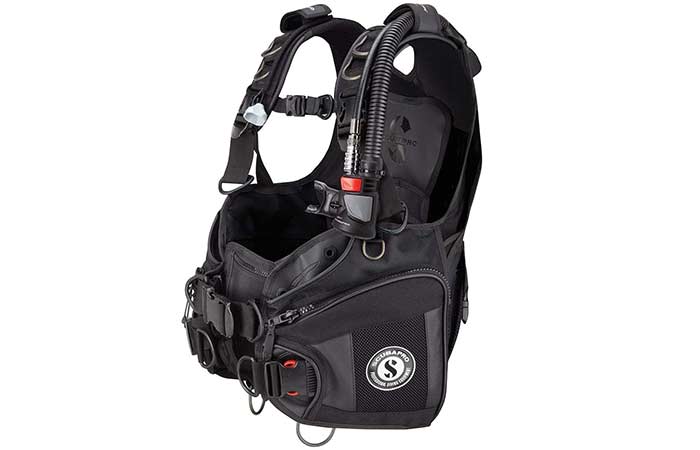
In the fourth position is the Scubapro X-Black. It is one of the most convenient, comfortable and performance-focused BC. Going by the available data from online search engines like Google, it is one of the most sought BCD on the internet.
Though quite pricey, it is the perfect BC for divers who like the comfort and security that comes with a front-adjustable BCD design
Design
This BCD has a great design given how easy it is to put on and take off. The Scubapro X-black is made from durable materials(1000 denier and 420 denier nylon) so you can be sure that this long-term investment will last for years to come.
The adjustable cummerbund compensates for suit compression, ensuring a snug fit at varying depths. The non-rotating quick-release shoulder buckles optimize strap routing to maximize fit.
This X-Black model comes with the fifth-generation AIR2 backup inflator regulator. Combining a backup regulator with a buoyancy control system, the AIR2 delivers air as smoothly as most primary second stages and is always within easy reach.
It also features a Super Cinch tank buckle system that locks the tank in for maximum stability
Performance
When it comes to performance, Scubapro X-Black is a little different than the typical BCDs. It has been designed with optimum performance for beginners and advanced divers alike, which means that you will be able to enjoy your diving experience at any stage of learning. The main performance features include
- Alternate Air Source: (AIR2_
- Airnet backpack- water-draining and comfortable during long dives.
- AirFlex system for enormous buoyant lift capacity.
Why buy it?
You are assured of quality. Like Cressi, Scubapro is reputable brand in the water sports industry, more especially in scuba diving. Scubapro creates excellent diving BCs, regulators as well as suits.
ScubaPro X-Black is one of the best buoyancy compensator devices you can find on today’s market. It is comfortable, secure easy to use and has a large amount of storage, but it doesn’t feel too bulky because the design is sleek and streamlined.
Its price is on the high-end and it is designed with pro scuba divers in mind.
5. Oceanic Jetpack Complete SCUBA Diving Travel System BCD Dry Backpack
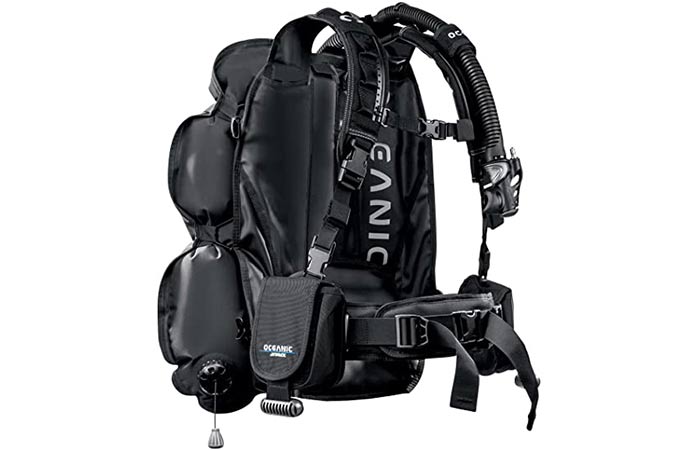
The Jetpack is a two-in-one travel kit that includes a bag and a BC. It is the ultimate solution for airline carry-on and transport to and from your dive site.
With the fully adjustable travel BC you can comfortably stay submerged in the water and with the semi-dry bag carry your bulky gear with ease while also keeping it safe from disaster situations and inclement weather during diving.
Design
To keep yourself buoyant when swimming down underwater trails or just relaxing on the surface of the sea, this BC comes equipped with an inflatable life jacket that’s both durable and easy to use.
Simply activate by pulling one cord and wait ten seconds before inflating fully with air. Once inflated, the Oceanic lifejacket will hold up to eight pounds worth of weight and is also equipped with a quick-release valve for easy deflation.
Performance
If you’re looking for a buoyancy compensator device with an above-average performance, the Oceanic Jetpack Complete SCUBA package is a great option.
For the price this BC/BCD combo offers good features that you wouldn’t find in other devices at its cost range. Oceanic has designed their product with divers who want to avoid excessive weight on long diving trips or for photographers and videographers looking for options they can travel conveniently with while still having all the functions needed when it comes time to diving.
The spacious (42 cubic liter) and light semi-dry bag has compartments to enable ease of packing and use during travel making it the perfect day bag for boat dives or shore excursions during your trip.
Why Buy it?
The Oceanic Jetpack includes two full sets of lightweight zipperless neoprene wings which are perfect if you’re dealing with issues like backpack fatigue from carrying your equipment too far as well as difficulty controlling buoyancy in rough water conditions.
The adjustable harness, cummerbund and lumbar lets you set a custom fit. It is a one-size-fits-all.
Other benefits include the ability to add a weight belt and the fact that it includes Oceanic’s patented dual bladder system with an extra fast fill rate and superior performance in cold water (40 degrees F or below).
Ocean BCD however lacks some features like the D-rings. Expect no regulator or hose. According to users, the straps may be shorter than expected.
6. Cressi R1 Lightweight Scuba Diving Jacket BCD
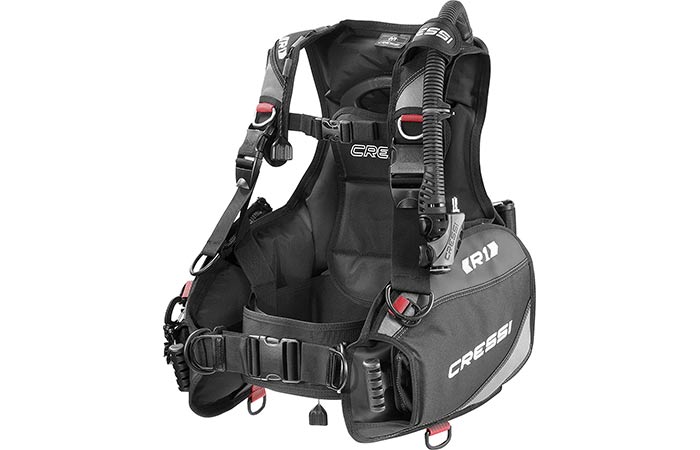
Yet another entry from Cressi is the R1. It is tough and rugged BCD with removable pockets that is specifically designed for beginner and frequent scuba divers who want a very complete yet light, hydrodynamic and affordable jacket. Its features include
- The Aquaride andour Aquapro 5 workhorse and the durable 500-Denier Cordura construction makes it ideal for rental solutions or for intense use.
- A rigid Back Plate that is Padded
- 3-exhaust valves to make buoyancy adjustments easy and 2 Large Zippered Pockets on for Convenient-Storage of accessories.
- The R1 Harness System uses Traditional Squeeze-Style Buckles and Adjustable Straps on the Shoulders, Chest and Waist for precise adjustment and fit.
- A Velcro Adjustable Waist Cummerbund provides extra Security and a superior comfort compared to any other BCD in the same category.
- The R1 BCD comes with the Integrated Lock Aid Quick-Release Weight System that holds up to 20 lb (9 kg), with 10 lb (4.5 kg) in each Pocket.
- A Built-In Carry Handle.
Why buy it?
It has a lightweight design and some of the best features from a reputable brand. It is versatile, durable, comfortable and convenient to use. This BCD can be adjusted easily with an integrated weight system which makes this device perfect for any type of diving.
You don’t need a tank to work with it hence quite convenient. Make adjustments is quite easy.
Unfortunately for some users, the hose connecting the regulator to the inflator, on some R1s sometimes does not stay in place as expected.
7. Hollis HD-200 BCD
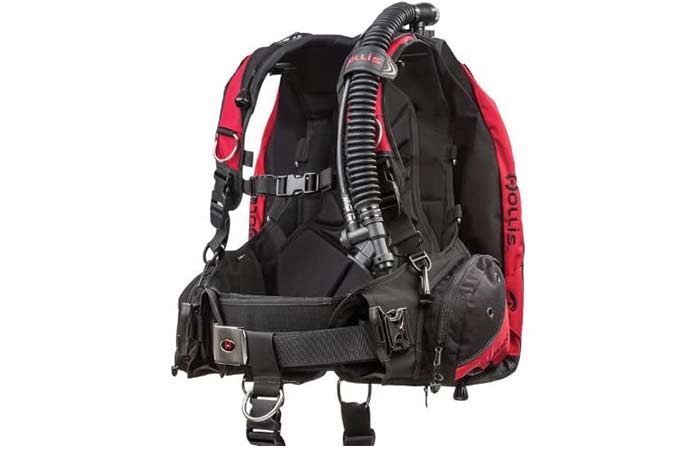
In 7th position is the Hollis HD-200 BCD. Hollis is best known for their military and commercial diving equipment, but they also offer a lightweight recreational BC designed to work best at depths of 60 feet or less. The HD-200 BCD is one of their best products to date.
Design
The design of this BCD is best suited for divers who are looking for a minimalistic approach to their equipment. It’s designed with comfort and mobility in mind, so it won’t cause drag or pull on the body of the user.
The Hollis HD-200 is made out of lightweight materials that make it easier to work with while diving; this also means that there will be less energy wasted when wearing it as opposed to other BCs.
Performance
The Hollis HD-200 BCD performs quite well given how easy it is to put it on, use it and take it off. The best thing about the Hollis HD-200 BCD is that it has a small profile and does not seem to get in the way when swimming.
This buoyancy compensator device is also easy to inflate with either your mouth or an inflation pump, which makes this product very convenient given its low price point. The best feature of all for this Hollis BCD though might be how easy it is to deflate since there are no valves you have to worry about getting clogged up water while on vacation. This saves us time from having to change out our equipment before diving.
Why buy it
The Hollis HD-200 features a large shoulder harness that allows the user’s arms full range of motion while maintaining maximum buoyancy control with minimal effort on your part.
The other nice features about this BCD are its stainless-steel hardware, heavy-duty nylon webbing straps (not just foam), crotch strap adjustability and versatility in use as either an adjustable weight system integrated into the backplate or two independent belts with buckles.
At only 12 lbs., it won’t be too hard on your back when you’re carrying it around during the diving expedition.
One favorite aspect about it is that many people who get back pain can wear this and not experience any discomfort on their spine. With this BC, you won’t feel fatigued at all after spending hours underwater exploring caves or shipwrecks. It’s definitely one of the top products out there if you want something lightweight which just works right.
Why it may not be a good choice
Some users have found the straps to be too long for their body. If you are of a medium height (5’9”), this may not be an issue but if you’re shorter or taller there might need to do some adjustments in order to have a comfortable fit with your Hollis BCD.
8. Mares Youth Scuba Ranger BC Vest
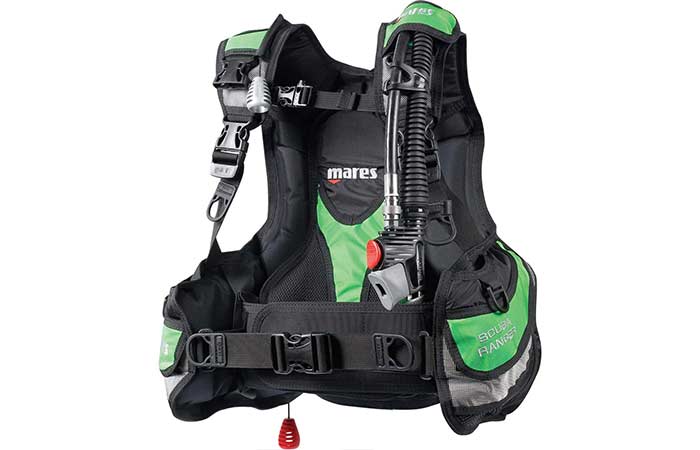
The final item in our list is the Mares Youth Scuba Ranger BC Vest. This is best for children ages six to twelve who are light or average weight, and best used during shallow dives. The vest comes in three different colors: black, blue, and pink so that your child can be stylish while diving.
Design
The best features of this BCD include the adjustable chest strap with Velcro closure for a more comfortable fit as well as an integrated weight system which helps keep them safe and secure underwater.
There’s also plenty of storage space on this device including two zippered wet pockets found around the hips and one zipper mesh pocket positioned over the stomach area where they can store all their little treasures like urchins or starfishes from their diving adventures.
Performance
Its features include a quick-adjusting buckle on shoulder straps for a snug fit, a padded neoprene backplate and front plate to help protect sensitive muscles in the back and hips from bruising while scuba diving with weight belts or tanks strapped across them, a front zipper that features an integrated cord lock closure system that ensures one-handed operation when needed most
Why Buy it
It comes at an affordable price. It is lightweight while also providing protection from scrapes against rocks or reefs on dives.
You can easily adjust the waist up and down, which makes it easy for kids to get into or out of the device. It also feels very comfortable when wearing it on your back, so there’s no pulling at all. Plus, the best part is that it comes in two sizes: Youth (ages 11-14) and Adult size (ages 15+).

